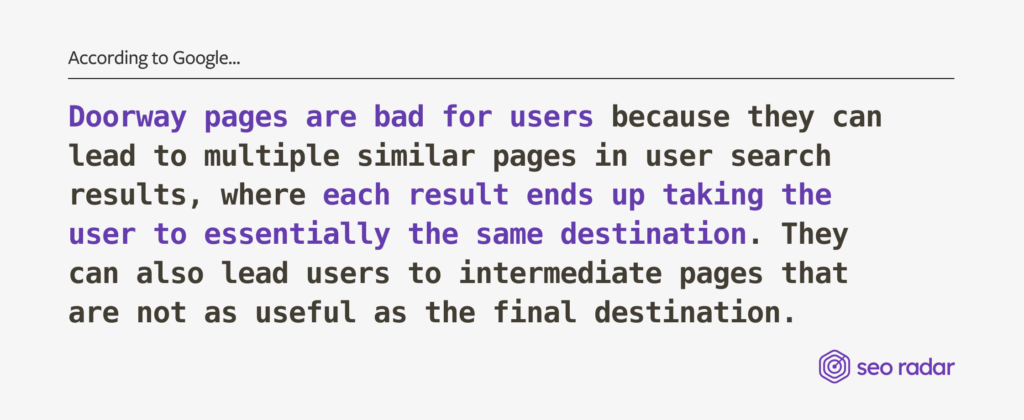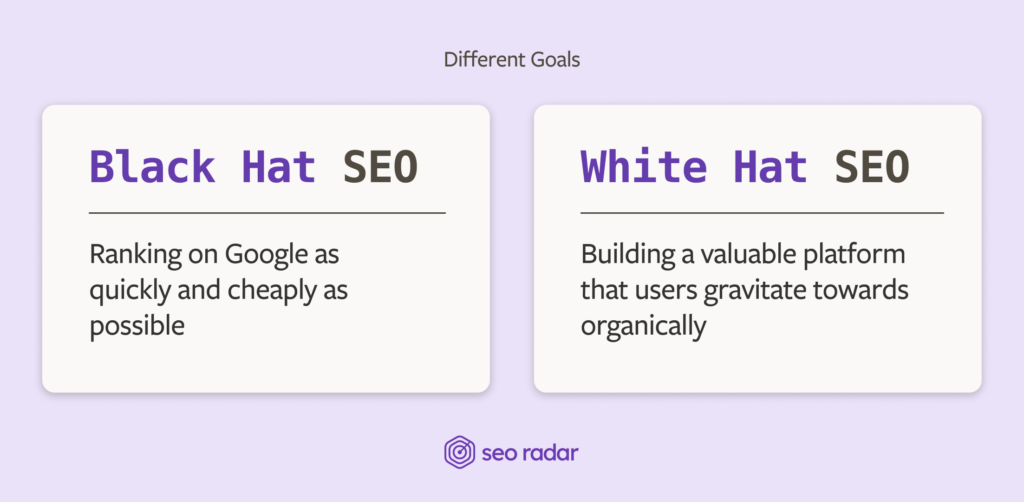A few years ago, many considered SEO a set of tricks to get the SERPs to give visibility to low-quality content. But, in the last couple of years, most search engines have evolved to make shady SEO practices (such as keyword stuffing) obsolete.
In many cases, these bad practices are associated with Black Hat SEO.
Ensuring your SEO practices align with the Webmaster Quality Guidelines is vital to building genuine and sustainable organic growth. But, what can you do to ensure this happens? In today’s post, we’ll explore it in detail.
We’ll discuss:
- What Black Hat SEO is
- What Black Hat SEO tactics You Should Avoid
- White Hat vs Black Hat SEO
- The risks associated with Black Hat SEO
Let’s begin!
What Is Black Hat SEO?
The term “Black Hat SEO” refers to the use of tactics that manipulate algorithms and violate search engine guidelines, with the intention of improving a website’s ranking. Additionally, some entrepreneurs use Black Hat tactics to push their competitors out of the top positions.
As the teams behind search engines became aware of how results could be hijacked, they refined their algorithms to make it harder for bad actors to get to the first page of the SERPs.
But, what are these black hat tactics?
9 Black Hat Tactics You Should Avoid
At this point, you already know what Black Hat SEO is. So, you may be wondering what are some examples of Black Hat SEO.
In its Webmaster Guidelines, Google mentions the following techniques:
- Keyword Stuffing
- Duplicate content or Content Spinning
- Hidden Text
- Doorway Pages
- Cloaking
- Misleading Redirection
- SEO Negative
- Paid Links
- Blog Spam
Keyword Stuffing
One of the first things you learn as an SEO is how to look for the right keywords to target.
Back in the early days, including the right keywords in the right places and at a high frequency was extremely important for SEO. But nowadays, Google focuses on providing users with reliable, high-quality results, so keyword stuffing will get you nowhere.
Using your target keywords too many times is considered bad practice because it lowers your content’s quality. In short, it makes you sound robotic and shifts your focus away from making quality material.
Let’s say you want to use your main keyword more than ten times. Eventually, you won’t know where else in the text to place it and you will end up with an unnatural-sounding piece of content that provides little value. Long-tail keywords tend to cause this problem the most.
Pro-Tip: Always create valuable content that aligns with your users’ search intent. Use keyword research to understand your users’ needs and questions, and include keywords naturally, only when they’re helpful. As a general rule, your main keyword should only appear on your meta title, your meta description, H1, H2, and a small number of times throughout your content.
Duplicate Content or Content Spinning
Unintentional duplicate content is one of the most common technical SEO issues. But some webmasters create duplicate content on purpose, with the intention of getting organic traffic with little effort.
Chances are that your duplicate content won’t give you the visibility you’re looking for. To have a better understanding of how Google handles duplicate content, check out this video:
You may also be interested in our guide to Keyword Cannibalization.
Third-party websites may infringe your copyright and use your content to rank. Unfortunately, in some cases, Google may struggle to identify the original author. If plagiarism is blatant and recurrent, you could contact the website’s hosting provider and demand that it be taken down.
Some website owners try to hide plagiarism and duplication by “spinning” the content. Basically, they upload the original material to a platform that rephrases it, so it appears as a new piece of content. Spinned content is usually hard to read and provides no original value. So it doesn’t work: Not for search engines, and not for users.
Hidden Text & Links
By including keywords in invisible elements, website owners do keyword stuffing without hurting their content’s quality. Google penalizes these types of “hacks” that add no real value to users. So, while including hidden text may sound logical, it’s not something we recommend.
According to Google, common ways to hide content include:
- Setting white text against a white background
- Placing text behind an image
- Positioning text off-screen with CSS
- Reducing the font size to 0px
- Using a single character as the anchor text for a link
While this low-value content may be hidden from users, search engines will detect it.
Doorway Pages
A gateway page is a page that only exists for the purpose of ranking content. Basically, they are orphan pages (i.e. pages that are not accessible through internal links), designed for search engines, not humans.
“Doorway pages are bad for users because they can lead to multiple similar pages in user search results, where each result ends up taking the user to essentially the same destination. They can also lead users to intermediate pages that are not as useful as the final destination.”
Doorway pages include:
- Incoherent paragraphs intended to position search queries and fail to address users’ real needs.
- Attempts to include certain keywords that lead users to a random page, often unrelated to the business.
In some cases, doorway pages are created automatically, to cover as many keywords as possible. However, as we mentioned previously, Google penalizes those SEO practices that don’t add real value. So creating these types of pages should be out of the question for your SEO team.
Cloaking
Through the practice of cloaking, website owners deliver one version of their content to search engine crawlers and a different version to human users.
It goes without saying that cloaking is a dishonest practice and contrary to SEO and UX best practices.
Misleading Redirects
Redirecting URLs is a very common SEO practice.
Redirects are extremely useful for:
- Creating a valuable user experience with as few dead ends as possible.
- Preserving your SEO wins after a website migration.
Like cloaking, redirection is sometimes used to show different content to users and search engines. For instance, when entering a URL, users may be directed to a different page, while the search engine may index the first one.
Negative SEO
Negative SEO is a malicious technique used to harm a competitor’s ranking.
Common negative SEO practices include:
- Creating low-quality backlinks to the competitor’s website
- Writing false negative reviews
- Slowing down the competitor’s website through forced crawls
In the short run, these methods might work, but they will hardly do so in the long term. Plus, some of them might even be illegal. For instance, some negative SEO practitioners hack their competitor’s websites or impersonate them online.
Pro-Tip: Instead of attacking your competitors, provide more value than them. Practice smart content skyscraping and implement an organic link-building strategy to support your efforts.
Paid Links
Link-building can be time-consuming and frustrating. That’s why some website owners decide to pay for backlinks. Considering that this violates Google’s Webmaster Guidelines, paid linking can result in penalties.
If you want to learn more about paid links, check out this video from Google Search Central:
Pro-Tip: If you want your content to be organically linked, create a useful resource targeted toward a certain audience and share it with content creators that can benefit from it.
Blog Spam
This Black Hat SEO method involves posting irrelevant comments on blog posts, including a link to your website. In other words, spamming.
This technique became less effective when the nofollow tag was created. Why? Because this tag tells search engines that all links inserted on a certain section of a website shouldn’t help build up authority.
Pro-Tip: To build your reputation and gain traffic, post helpful comments on blogs in your niche. The links you include won’t increase your DA, but the value you add may attract users to your website.
What Are the Risks of Using Black Hat SEO Tactics?
According to Google’s Webmaster Guidelines:
“If a site has been affected by a spam action, it may no longer show up in results on Google.com or on any of Google’s partner sites”
Most of the Black Hat SEO techniques we mentioned in the previous section were once acceptable strategies to get visibility on Google. But today, they can have the exact opposite effect.
The main risks associated with Black Hat SEO are:
- Significantly reducing your website’s visibility and traffic.
- Delivering a poor user experience that fails to drive business results.
- Hurting users’ perception of your brand.
White Hat vs Black Hat SEO
In this section, we’ll explain the opposite approach: White Hat SEO. When we talk about white hat methods, we’re referring to all SEO practices that comply with search engines’ guidelines.
They focus on:
- Meeting the needs of the user, by taking their search intent into account.
- Providing the user with informative and enriching content.
- Optimizing UX elements and complying with Core Web Vitals standards.
Now, what exactly is the difference between a black hat and a white hat technique?
The key difference between black hat and white hat techniques is intentionality.
| Black Hat SEO | White Hat SEO | |
| Content quality | Low-quality and duplicate content | Original, valuable & relevant content |
| Images & alt-tags | Stolen images with keyword-filled alt tags | Original images with appropriate alt text |
| Backlinks | Low-quality paid links | Quality resources that generate organic links |
| Approach to keyword research | Keyword research as a means to rank on Google | Keyword research as a means to understand user needs |
| Goal | Ranking on Google as quickly and cheaply as possible | Building a valuable platform that users gravitate towards organically |
In most cases, combining white hat and black hat practices isn’t convenient. Using Black Hat SEO tactics can lead you to be penalized by Google and shunned by users.
For Long-Term SEO Success, Optimize Your Site’s Content & Indexability
As SEO experts, we don’t recommend implementing Black Hat SEO practices at all. These strategies don’t give you sustainable results, they’re disrespectful to your users, and they hurt your brand.
It’s therefore vital to be aware of these SEO mistakes, especially because you may be committing them unknowingly.
An SEO strategy takes time, and using unethical practices can not only give you a bad reputation but also make your domain impossible to rank.
In order to rank organically, we recommended you avoid black hat tricks and concentrate all your efforts on:
- Creating great content that users genuinely enjoy.
- Distributing your content efficiently through social channels.
- Building relationships with content creators in your niche.
- Constantly monitoring your technical SEO.
The quality of your content is important, but you also need your website to be easy to crawl and index. That’s where SEORadar can help.
SEORadar monitors your website’s code and notifies you of any technical changes that affect your rankings or keep Google from indexing your pages correctly. With SEORadar, you can identify SEO issues before they negatively impact your site.
Interested? Start a free trial or schedule a demo.







